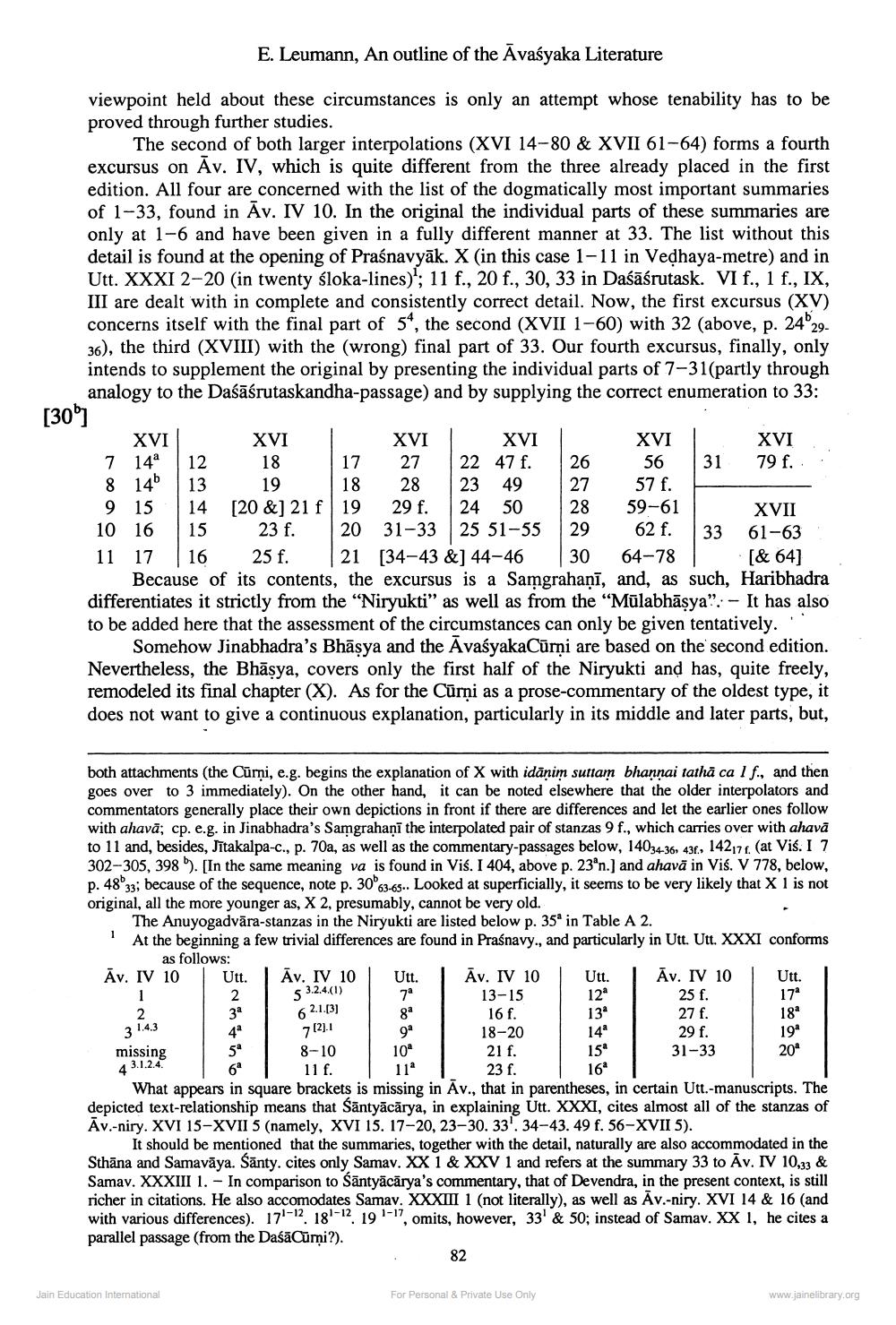________________
E. Leumann, An outline of the Avasyaka Literature
viewpoint held about these circumstances is only an attempt whose tenability has to be proved through further studies.
The second of both larger interpolations (XVI 14-80 & XVII 61-64) forms a fourth excursus on Av. IV, which is quite different from the three already placed in the first edition. All four are concerned with the list of the dogmatically most important summaries of 1-33, found in Av. IV 10. In the original the individual parts of these summaries are only at 1-6 and have been given in a fully different manner at 33. The list without this detail is found at the opening of Praśnavyāk. X (in this case 1-11 in Vedhaya-metre) and in Utt. XXXI 2-20 (in twenty śloka-lines)'; 11 f., 20 f., 30, 33 in Daśāśrutask. VI f., 1 f., IX, III are dealt with in complete and consistently correct detail. Now, the first excursus (XV) concerns itself with the final part of 54, the second (XVII 1-60) with 32 (above, p. 242 36), the third (XVIII) with the (wrong) final part of 33. Our fourth excursus, finally, only intends to supplement the original by presenting the individual parts of 7-31(partly through analogy to the Daśāśrutaskandha-passage) and by supplying the correct enumeration to 33:
29
[30]
XVI
XVI
17
19
18
56 57 f. 59-61 62 f. 64-78
[20 &] 21 f 19 23 f. 20 11 17 16 25 f. 21 [34-43 &] 44-46 [& 64] Because of its contents, the excursus is a Samgrahaṇī, and, as such, Haribhadra differentiates it strictly from the "Niryukti" as well as from the "Mūlabhāṣya". It has also to be added here that the assessment of the circumstances can only be given tentatively.
Somehow Jinabhadra's Bhāṣya and the AvasyakaCūrṇi are based on the second edition. Nevertheless, the Bhāṣya, covers only the first half of the Niryukti and has, quite freely, remodeled its final chapter (X). As for the Curni as a prose-commentary of the oldest type, it does not want to give a continuous explanation, particularly in its middle and later parts, but,
7 14a
8
14b
9
10
15
16
as follows: Av. IV 10
1
12
13
14
15
2
3 1.4.3
XVI
18
missing 43.1.2.4
Jain Education International
XVI
Utt. Āv. IV 10 5 3.2.4.(1)
2
3a
2.1.[3]
7 [2].1
8-10
XVI
27 22
28
23
24 50
29 f. 31-33
25 51-55
both attachments (the Curni, e.g. begins the explanation of X with idānim suttam bhannai tatha ca 1 f., and then goes over to 3 immediately). On the other hand, it can be noted elsewhere that the older interpolators and commentators generally place their own depictions in front if there are differences and let the earlier ones follow with ahava; cp. e.g. in Jinabhadra's Samgrahaṇī the interpolated pair of stanzas 9 f., which carries over with ahavā to 11 and, besides, Jītakalpa-c., p. 70a, as well as the commentary-passages below, 14034-36, 43f., 14217 f. (at Viś. I 7 302-305, 398). [In the same meaning va is found in Vis. I 404, above p. 23 n.] and ahavā in Vis. V 778, below, P. 48°33; because of the sequence, note p. 30° 63-65.. Looked at superficially, it seems to be very likely that X 1 is not original, all the more younger as, X 2, presumably, cannot be very old.
The Anuyogadvara-stanzas in the Niryukti are listed below p. 35a in Table A 2.
1 At the beginning a few trivial differences are found in Praśnavy., and particularly in Utt. Utt. XXXI conforms
47 f. 49
Utt.
7a
ga
Av. IV 10
13-15
16 f. 18-20 21 f. 23 f.
5a
10a
6a
11 f.
112
What appears in square brackets is missing in Av., that in parentheses, in certain Utt.-manuscripts. The depicted text-relationship means that Santyācārya, in explaining Utt. XXXI, cites almost all of the stanzas of Av.-niry. XVI 15-XVII 5 (namely, XVI 15. 17-20, 23-30. 33. 34-43. 49 f. 56-XVII 5).
82
26
27
28
29
30
For Personal & Private Use Only
31
Utt. 12a
13a
14a
33
15
16a
XVI
79 f.
XVII 61-63
Av. IV 10 25 f.
27 f.
29 f.
31-33
It should be mentioned that the summaries, together with the detail, naturally are also accommodated in the Sthāna and Samavāya. Santy. cites only Samav. XX 1 & XXV 1 and refers at the summary 33 to Av. IV 10,33 & Samav. XXXIII 1. - In comparison to Santyācārya's commentary, that of Devendra, in the present context, is still richer in citations. He also accomodates Samav. XXXIII 1 (not literally), as well as Av.-niry. XVI 14 & 16 (and with various differences). 171-12, 181-12. 19 1-17, omits, however, 33' & 50; instead of Samav. XX I, he cites a parallel passage (from the DaśāCumi?).
Utt.
17a
18a
19a
200
www.jainelibrary.org




